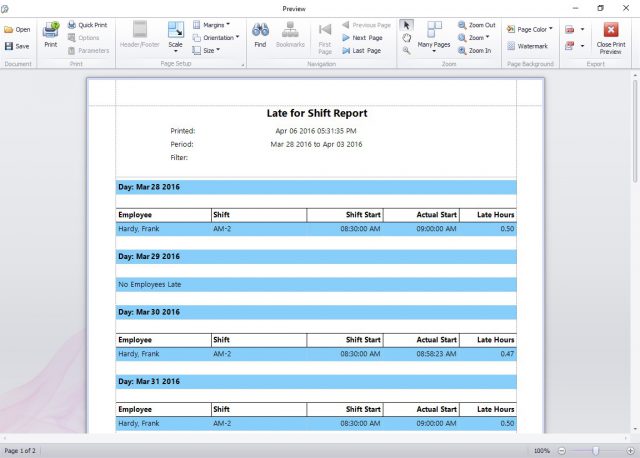Above is a statement from Kristina Harford who is the operations manager at Infectious Disease Associates of Tampa Bay. She’s talking about Time Clock MTS, which her company has been using as an employee time management system for several years. There’s no doubt that controlling tardiness of employees is a key role of any department supervisor or payroll department and a good staff clock in system should allow those same things to be recorded and monitored easily.
What is Tardiness and is it a Problem?
Tardiness is the delay between an employee starting work and when they should have started work. It’s also lateness during the work day, such as being late back from lunch, arriving at meetings late, and being late to customer appointments. In this article I’ll just be considering tardiness as “being late to work”. Is tardiness a problem? The answer is yes. In 2011 Careerbuilder suggested that tardiness was an important issue in the US labor market with 16% of employees late to work at least once per week and more than a quarter of employees late to work at least once a month. HR Magazine stated in 2005 that tardiness was costing the US economy more than $3 billion a year.
More recently, in the much smaller British economy it has been suggested that employees being late to work is costing the British economy more than $14 billion per year and that the average amount of time staff are late to work is nearly 4 minutes per day. Here’s what one business owner in that article said about employees being tardy:
“Time is money and when it comes to making business journeys, punctuality and speed are crucial.”
So What Does Tardiness Actually Cost?
It’s easy to assume that tardiness cost is calculated by multiplying the employee’s hourly rate by the amount that they are late. But, some human resources experts suggest that the real monetary cost of an employee being late is 2-3 times their hourly rate. This approach considers the cost of the employee’s time, the cost of the office/factory/store space that is going unused while the employee is not working and the cost of employee overheads and benefits, I’ll take this one step further and suggest that the opportunity cost of foregone profit should also be considered when an employee is continually late.
So how much does an employee being late to work actually cost? In the interests of being conservative I’ll just go ahead an assume that the real cost of tardiness is the hourly rate of the employee multiplied by the time the employee is late. Given that the median wage in the US is about $13 per hour an employee that is 15 minutes late once a week is costing you $169 per year. A great example in non monetary terms is that if an employee is late to work just 10 minutes each day then you, are in effect, giving them an extra week of paid vacation each year. Whatever way you look at it, late employees cost money and it cannot be ignored.
Tardiness Costs More Than Money
There’s a financial aspect to employee tardiness that cannot be ignored. But there are other, less easy to measure costs that tardiness has on the business. What these costs are is worthy of an article by itself but here’s a few impacts of late employees that you might not have considered:
- Generally employees do not want to be late to work. When an employee arrives late to work they are often flustered and upset and may take quite a while to settle into their daily work.
- Less time at work leaves the employee with less time to complete their allotted tasks. It’s likely that their quality of work will suffer.
- Tardiness can be a sign of underlying employee morale problems. If tardiness is being ignored then you could be ignoring deeper problems in your business.
- Other (on-time) employees can be upset by employees who are continually late to work without that behavior being controlled.
- Your customers can suffer. If employees are late opening up a shop or store then clearly that is going to cost you money. If your employee is late for customer meetings then that’s going to impact on the image that your business has in the marketplace.
Identify Lateness Trends Early
It’s imperative to identify lateness trends early. An employee who suddenly starts being tardy to work can be an employee who is suddenly suffering family or personal stress. Early identification can mean a quick discussion with the employee and either a solution to the lateness being found or the employer being flexible for an amount of time while the employee resolves their personal issues. Identification of a long term habit of lateness can point to underlying causal problems for an employee, perhaps transport problems, perhaps simple problems with time management, or perhaps dissatisfaction with their job. Whatever the case identifying the trend and then addressing the issue with the employee can potentially be far more effective than trying to enforce a no-questions-asked start time for work policy.
How Employee Time Management Systems can help Manage Employee Tardiness

The late for shift report displays all employees that have arrived for work after their designated shift start times.
A great employee time management system like Time Clock MTS will help you monitor employee tardiness as a normal part of your payroll duties. The system will allow your employees to clock in and out with a minimum of fuss and it should then produce easy to understand reports showing exactly when your employees arrived at work. Ideally there’d be some dedicated reports designed specifically to help identify employees who are late for work (such as the late for shift report in Time Clock MTS, see image above). The timeclock software should also provide a quick visual method of identifying who is or isn’t at work at any point in time.
Above you can see what Angie Andrade-Morioka, the directory of staffing and facilities at the University of Hawaii at Hilo had to say about how they are using Time Clock MTS to track tardiness. Remember, an employee who is late to work just once per week can be costing you up to $200 per year. Time Clock MTS has a fully functional 30 day trial available and costs just $99 (US) for the Stand Alone Version. If it can help you prevent just one employee tardy per week then it’ll pay for itself 2-3 times over in just a year. Why not give it a try!



